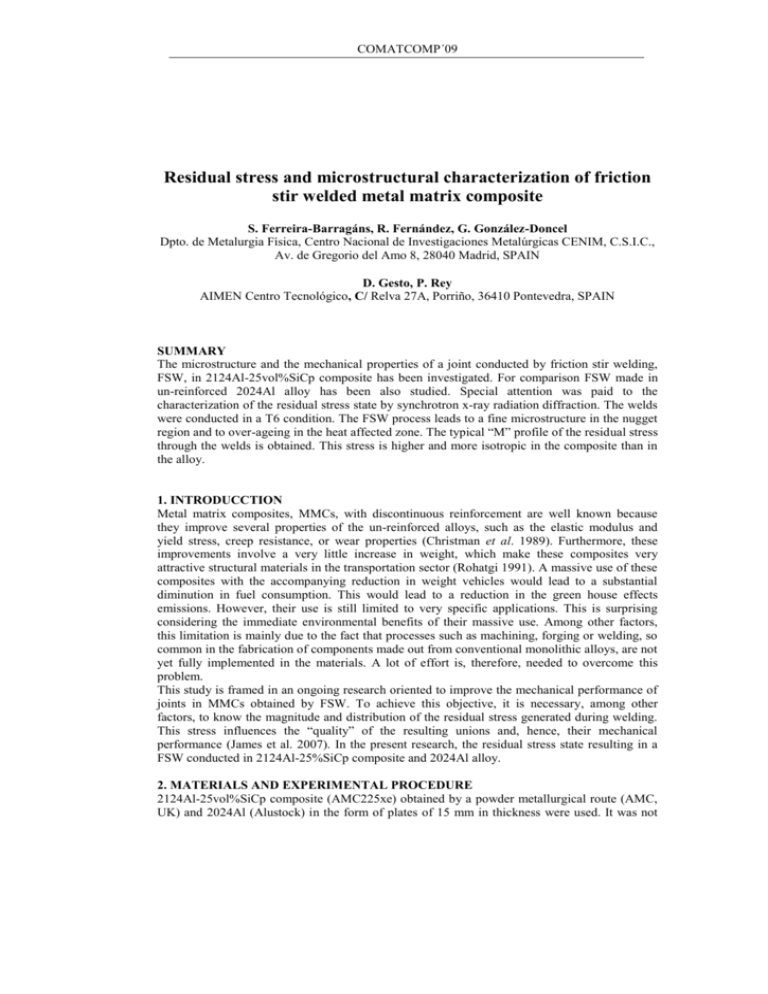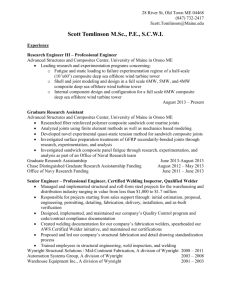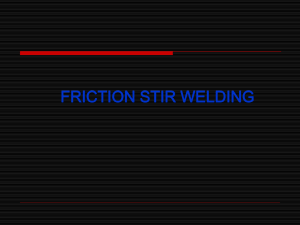Residual stress and microstructural - digital
advertisement

COMATCOMP´09 Residual stress and microstructural characterization of friction stir welded metal matrix composite S. Ferreira-Barragáns, R. Fernández, G. González-Doncel Dpto. de Metalurgia Física, Centro Nacional de Investigaciones Metalúrgicas CENIM, C.S.I.C., Av. de Gregorio del Amo 8, 28040 Madrid, SPAIN D. Gesto, P. Rey AIMEN Centro Tecnológico, C/ Relva 27A, Porriño, 36410 Pontevedra, SPAIN SUMMARY The microstructure and the mechanical properties of a joint conducted by friction stir welding, FSW, in 2124Al-25vol%SiCp composite has been investigated. For comparison FSW made in un-reinforced 2024Al alloy has been also studied. Special attention was paid to the characterization of the residual stress state by synchrotron x-ray radiation diffraction. The welds were conducted in a T6 condition. The FSW process leads to a fine microstructure in the nugget region and to over-ageing in the heat affected zone. The typical “M” profile of the residual stress through the welds is obtained. This stress is higher and more isotropic in the composite than in the alloy. 1. INTRODUCCTION Metal matrix composites, MMCs, with discontinuous reinforcement are well known because they improve several properties of the un-reinforced alloys, such as the elastic modulus and yield stress, creep resistance, or wear properties (Christman et al. 1989). Furthermore, these improvements involve a very little increase in weight, which make these composites very attractive structural materials in the transportation sector (Rohatgi 1991). A massive use of these composites with the accompanying reduction in weight vehicles would lead to a substantial diminution in fuel consumption. This would lead to a reduction in the green house effects emissions. However, their use is still limited to very specific applications. This is surprising considering the immediate environmental benefits of their massive use. Among other factors, this limitation is mainly due to the fact that processes such as machining, forging or welding, so common in the fabrication of components made out from conventional monolithic alloys, are not yet fully implemented in the materials. A lot of effort is, therefore, needed to overcome this problem. This study is framed in an ongoing research oriented to improve the mechanical performance of joints in MMCs obtained by FSW. To achieve this objective, it is necessary, among other factors, to know the magnitude and distribution of the residual stress generated during welding. This stress influences the “quality” of the resulting unions and, hence, their mechanical performance (James et al. 2007). In the present research, the residual stress state resulting in a FSW conducted in 2124Al-25%SiCp composite and 2024Al alloy. 2. MATERIALS AND EXPERIMENTAL PROCEDURE 2124Al-25vol%SiCp composite (AMC225xe) obtained by a powder metallurgical route (AMC, UK) and 2024Al (Alustock) in the form of plates of 15 mm in thickness were used. It was not COMATCOMP´09 possible to obtain 2124Al alloy plate of this thickness. The pieces to be joined were first heat treated to a T6 or fully hardened condition. His treatment consists on a solution treatment at 530ºC during 2h followed by quenching in oil bath at 20ºC and subsequent annealing at 160ºC during 18h for the composite and 20h for the alloy. 2.1 Description of the FSW process After the T6 treatment, butt joints were conducted in two passes, on both sides of the plates, without any previous surface preparation. The FSW tool had a fixed threaded pin of truncated cone geometry and three grind flats at 120º. The tool was fabricated from H13 (Q&T, 49 HRc) material except for the pin, which was fabricated from multiphase MP159 alloy. The welding conditions are summarized in Table 1. Material 2024Al-T6 2124Al-25vol%SiCp-T6 Rotation speed (rpm)* 400 300 Welding speed (mm/min) 100 75 Force (kN)** 23 8.5 * CCW (counter-clock wise). ** Position control. Table 1: Parameters employed in the FSW process. 2.2 Microstructural and mechanical characterization The microstructure was studied by optical and scanning microscopy on samples prepared by conventional metallographical procedures. Vickers hardness tests, HV5, were made on an EMCOTEST M10 010 hardness testing machine. Hardness maps of the welds were obtained by indenting on different positions along several lines, such that a grid of 5x5 mm2 in size was completed. 2.3 Determination of the residual stress on the welded unions Near surface residual stress values across the welds (first pass) have been obtained by synchrotron radiation diffraction in energy dispersive mode (in reflection) in the range 10-150 keV, at EDDI line of BESSY, Berlin, Germany. This mode allows obtaining many diffraction peaks simultaneously. Here, only the results from the 311 reflection will be presented. This peak presents a low plastic anisotropy and, hence, the relationship between the lattice parameter an the stress is approximate linear. The analysis o the remaining peaks is being the subject of another study. The Bragg’s angle was =4º. The primary slit was of 1x1 mm2 and the secondary one was of 1x0.03 mm2 (gage volume: 1x1x0.03 mm3). Both the longitudinal, L (along the welding), and transverse, L (across the welding), components of the residual stress were determined from the strains assuming a biaxial stress state (N = 0, sub-index N indicates normal direction to the sample surface). L,T E T , L L,T 1 1 2 (1) where L y T are the strains along the longitudinal and transverse directions, respectively, E is the Young’s modulus, and is the Poisson’s ratio. The sen2method, where is the angle between the scattering vector and the sample axis direction, was employed for this purpose. The un-stressed lattice parameter, d0,, was measured on comb type of samples to take into account the possible microstructural and chemical changes introduced by the FSW process (Pratihar et al. 2006). COMATCOMP´09 3. RESULTS AND DISCUSSION Macrographs of the resulting welds (cross section) are shown in fig. 1. Welding “quality” is better in the alloy than in the composite. The welding in the composite is not as good as expected due to the presence of “tunnel defects (fig. 1b). This suggests that the welding parameters are more critical in the composite than in the alloy, and that these parameters must be optimized. The grains size in both cases in clearly reduced. Hardness is higher in the composite (~170 HV) than in the alloy (~110 HV), and in both materials hardness decreases in the welding region due to over-ageing associated to heating produced by the FSW process. a) b) 180-190 170-180 Fig. 1. Macrographs of the FSW samples. a) 2024Al Alloy, b) 2124Al-25vol%SiCp 160-170 120-130 150-160 composite. 110-120 100-110 The variation of d0 is summarized in figure 2. This variation indicates structural changes introduced by the FSW process: These are more pronounced in the composite than in the alloy. It is also seen that d0 is, in average, higher in the composite. This result points out the strong dependency of this parameter on the alloying elements. Fig. 2. Typical “comb” sample used to measure the un-stressed lattice parameter, d0. Variation of d0, across the weld, in the alloy and the composite. The results of the residual stress analysis are shown in fig. 3. It is seen the typical “M” variation of the residual stress across the welds (Mishra et al. 2005). The residual stress state is more isotropic in the composite than in the alloy. In the latter one, the longitudinal component is clearly higher than the transverse one. The residual stress gradient is also higher in the composite than in the alloy. The isotropic character of the stress in the composite could be attributed to the tunnel defects arising during the FSW process. In turn, these defects could be a consequence of the high stress level achieved during FSW, associated to the microscopic residual stress state in the composite. This stress is due to the presence of the ceramic COMATCOMP´09 reinforcing particles in this material. The imperfections in the composite may have released partially the residual stress in this material. Fig. 3 Residual stress profiles resulting from the FSW process in the alloy and the composite. 4. CONCLUSIONS 1.- The weld quality is better in the alloy than in the composite due to the presence of tunnel defects in the latter one. This result reveals the present difficulty of joining plates from metal matrix composites of several mm in thickness by FSW. 2.- variations of d0 across the welds reveals structural changes during the FSW process. 3.- The residual stress in both materials follow the typical “M” profiles. This stress is more pronounced an isotropic in the composite than in the alloy. The residual stress gradient is also higher in the composite, possibly due to the additional contribution of a microscopic residual stress associated to the presence of the ceramic particles. ACKNOWLEDGEMENTS. Projects MAT-05-0527 and PTR95-1007-OP from MICINN (Ministerio de Ciencia e Innovación), Spain, and contract nº RII 3CT-2004-506008 from BESSY, Germany. REFERENCES CHRISTMAN T., NEEDLEMAN A. and SURESH S. (1989) An experimental and numerical study of deformation in metal-ceramic composites, Acta Metall., 37, 3029-3050. ROHATGI P. (1991) Cast aluminum-matrix composites for automotive applications, JOM, 43, 10-15. JAMES M.N., HUGES D.J., CHEN Z., LOMBARD H., HATTINGH D.G., ASQUITH D., YATES J.R., WEBSTER P.J. (2007) Residual stresses and fatigue performance, Engineering Failure Analysis 14, 384-395. NOYAN I.C. and COHEN J. B. (1987) Residual Stress: Measurements by Diffraction. Springer Verlag. PRATIHAR S., STELMUSKH V., HUTCHINGS M.T, FITZPATRICK M.E., STUHR U., EDWARDS L. (2006) Measurement of the residual stress field in MIG-welded Al-2024 and Al7150 aluminium alloy compact tension specimens, Materials Science and Engineering A 437, 46-53. MISHRA R.S., Ma Z.Y. (2005) Friction stir welding and processing, Materials Science and Engineering R 50, 1-78.




